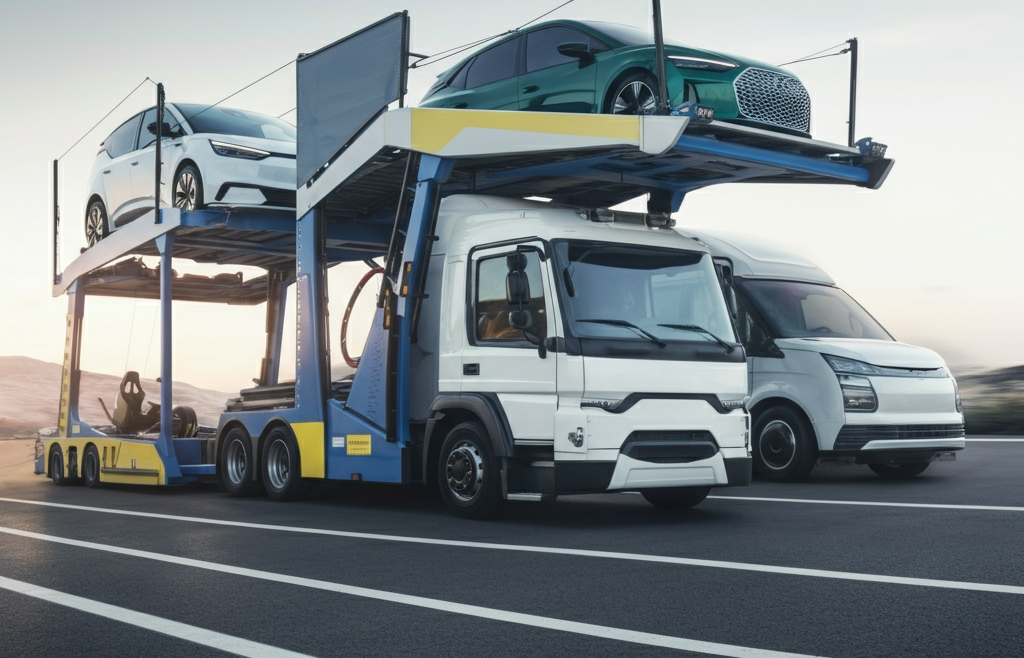Transporting electric vehicles requires specialized expertise to ensure their safety and efficiency throughout the journey. High-end EVs, with their cutting-edge technology and significant value, demand meticulous planning and adherence to strict safety protocols. This guide explores the key steps and considerations for safely and efficiently transporting these advanced vehicles.
Why High-End EVs Require Special Attention
Transporting electric vehicles, especially high-end models, requires special attention due to their sophisticated technology and delicate components, such as lithium-ion batteries, which are highly sensitive to temperature and physical damage. Unlike conventional vehicles, their transportation involves considerations such as battery health, weight distribution, and compliance with stringent regulatory standards.
Additionally, the high monetary value of these vehicles makes their protection a top priority. Neglecting even minor aspects of preparation or handling can lead to substantial financial and reputational losses.
Key Preparations Before Transporting EVs
Proper preparation is the foundation of safe and efficient transporting electric vehicles. The following steps are essential.
Battery Management
The battery is a critical component of any electric vehicle and requires meticulous attention. Maintaining the charge within an optimal range, typically between 20% and 50%, is crucial to reducing risks such as thermal fluctuations. It’s essential to avoid fully charging or completely draining the battery before transit. Manufacturers often provide guidelines for placing the battery into transport or storage mode, which helps prevent unnecessary power draw and overheating. In regions with extreme temperatures, using climate-controlled carriers is recommended to protect the battery from thermal stress.
Inspection and Documentation
Conducting a thorough inspection of the vehicle is an indispensable step before transporting electric vehicles. Carefully examine the car for any existing damage, recording its condition in detail by making photos, videos, and notes. Photographs and written documentation help establish accountability and are often required for insurance purposes. Ensure all systems, including brakes, lights, and onboard electronics, are functioning properly. Additionally, recording essential data such as the battery charge level and mileage provides a clear baseline for the vehicle’s condition before transport.
Secure Loose Components
Loose components and accessories can cause significant damage if not properly managed. Detachable parts like roof racks, custom accessories, or spoilers should be either removed or firmly secured. Charging cables must be stored in designated compartments or tightly fastened to prevent movement during transit. To enhance safety further, deactivate any self-driving or remote-access features to ensure the vehicle remains stable and inactive throughout the journey.
Selecting the Right Transport Method
Transporting electric vehicles safely requires choosing the right method to ensure the safety of high-end EVs.Available options include:
- Enclosed carriers are the best for protecting vehicles from weather and debris during long-distance transportation.
- Flatbed trucks are suitable for short distances or oversized vehicles.
- Container shipping is ideal for international transport, providing extra security against environmental factors.
Each method has its benefits and should be selected based on the vehicle’s size, destination, and specific requirements.
Ensuring Safety During Transportation
When it comes to transporting electric vehicles, ensuring their safety throughout the journey is crucial.
- Use climate-controlled carriers to maintain optimal conditions, especially for the battery system.
- Minimize vibrations and shocks using advanced suspension systems in the carrier.
- Implement tracking systems for real-time updates and constant monitoring of the vehicle’s condition during transport.
- Adhere to safety protocols that ensure secure loading and unloading to avoid any physical damage.
Navigating Legal and Regulatory Requirements
Transporting electric vehicles involves adhering to a myriad of regulations, which vary by region and transportation method. These may include:
- Compliance with battery transport guidelines, as lithium-ion batteries are classified as hazardous materials.
- Meeting emission standards for the carriers.
- Ensuring proper licensing and documentation for cross-border transportation.
Familiarity with these legalities prevents delays and potential fines.
The Importance of Insurance for EV Transport
When transporting electric vehicles, especially high-end models, comprehensive insurance coverage is indispensable due to their high value. A robust policy should cover:
- Damage due to accidents or environmental factors.
- Theft during transit.
- Liability coverage in case of third-party claims.
Insurance ensures peace of mind for all stakeholders involved in the transportation process.
Choosing the Right Transport Partner
Partnering with an experienced and reliable logistics provider is crucial for seamlessly transporting electric vehicles. A professional company, like Wincom Logistik, offers:
- Expertise in handling high-end vehicles with precision.
- Advanced tracking systems for real-time updates.
- The latest technology and equipment to handle high-end EVs safely.
- Understanding of the international regulations for trouble-less shipping.
- Personalized services tailored to unique requirements.
With a trusted partner, you can avoid unnecessary risks and delays.
Common Mistakes to Avoid When Transporting EVs
Transporting electric vehicles successfully involves avoiding these common pitfalls:
- Ignoring battery care can lead to significant damage.
- Loose or incorrectly secured vehicles are prone to movement and damage during transit.
- Inadequate carriers may fail to protect the vehicle from environmental or physical harm.
- Non-compliance with laws can result in fines or transportation delays.
Transporting electric vehicles, especially high-end ones, safely and efficiently requires meticulous planning, adherence to safety protocols, and expertise in logistics. By following these guidelines and choosing a reliable transport partner, you can ensure your EV reaches its destination in pristine condition. Wincom Logistik stands ready to support you with expert services tailored to meet the demands of this specialized task.


Leave a reply